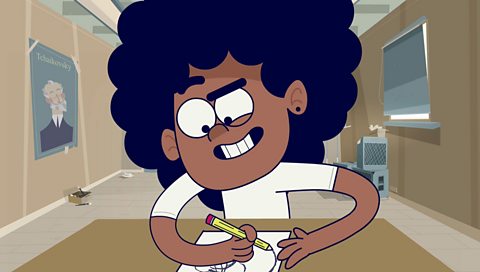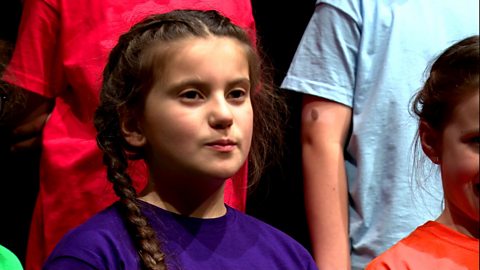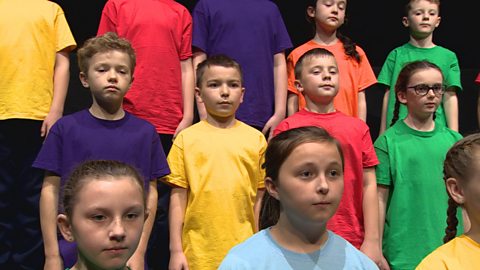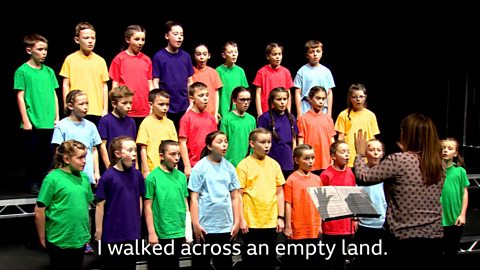Watch: Creating music using our environment
You can make music using found soundsSounds that are made from objects which can be found around you. from our environment. But we can also use the local environment to inspire us and give us ideas for a musical compositionCreating or writing a piece of music..
When you composeTo write your own music. a piece of music that is inspired by or describes a place, it's called programme music.
Discover how the children are inspired by their local town's features. The river and bridge provide them with inspiration to create a musical piece.
0:08John Kefala-Kerr's work involves collaborating with all sorts of musicians and today is no exception.
0:16He's keen to find out what Emily, Nathan, Rachel, Maddie and Macy, Alex and Paul can come up with, especially since none of them have ever tried to compose a piece of music before.
0:30First, it's down to the river to soak up some inspiration, the waves on the water.
0:35There's like when it's closer to the shore, they're quite small and gentle.
0:39But as you go further into the water, they get larger and less, more choppy.
0:43What about this object in front of us?
0:47So I think we should start with like more of a simple melody to start with and then like build it up to like making like an arch of the bridge.
0:57And that's quite a complex lattice work of girders and metal work.
1:03Can you picture a musical, you know, a way of, of doing that musically?
1:18It's got a really interesting shape to it.
1:21Tell us about it.
1:22Well, I was thinking about the smoothness and the river, how relaxing, calm and shape it around that.
1:28Really?
1:29I think Emily's little melody sounds more like the arch of the bridge because it starts like quietly and then it gets louder and then it fades away.
1:40I like the heavy sound of anything.
1:43It represents the heavy metal of the bridge.
1:55But so just me, Maddie's come up with a simple melody that she hopes will work really well.
2:04Nathan is learning the chord structure.
2:08They let me, he in turn works with Emily, the French horn player as they both layer in their sounds to complement the piano melody.
2:24They're really just improvising with the melody and playing about to see what works.
2:29Ok.
2:30And what I want to do is I want to give, let the room have the first word.
2:37OK.
2:40The Children use a single sound or a chord to fill the silence of the room.
2:51And then together they use that to build a multilayered sound.
Watch: Performing a musical composition
Watch the children perform their composition. Think about what instruments they used to represent the river and bridge.
John: 1,2,3…
Student: Never really composed before.The part that I enjoyed most about the whole composing process, was after having all the inspiration finally turning it into a piece.
Student 2: It was very helpful to see like how the river moved and the structure of the bridge and how we could use that to compose the piece of music.
Student 3: You got different instruments and you don't know like, whether or not they will clash or fit. So I'm really pleased because it sounds really good.
Student 4:I've enjoyed most about when we went to the river. It's been really fun.
Student 5: Being able to work with friends, on like one big composition, has been really good fun. We've got a really nice outcome.It's just amazing.
What instruments did you spot?
To create their musical piece, the children used:
- a violin
- a guitar
- a French horn
- a piano
- drums
Are there things in your local environment that might inspire you to compose a musical composition?
What might they be?
What is programme music?

A famous example of programme music is 'Mars' by the composer Gustav Holst.
His Planets suite describes each of the planets in our solar system.
Holst composed this piece in anticipation of the outbreak of World War One.
In ancient Roman religion, Mars was the god of war.

Watch: 'Mars' by Holst
Explore some of the inspiration behind Holst's piece 'Mars' with Dick and Dom.
Destination site, input hyperspeed system coordinates.
Engage rear rockets.
And activate thrusters.
Activating, umm…
Ever wanted to travel through time and space? Well you don’t need a lovely spaceship like mine!All you need is some fantastic classical music. And your imagination!
See classical music is a little bit like having a spaceship. It can take you anywhere you want.
So, when a man called Gustav Holst wanted to explore the planets…
Destination up ahead…
…he went into space, using his imagination.
Destination right there!
And he dreamt up music about Venus, Jupiter, Mercury and Mars.
Oh, this music is beautiful!
It's big and it's making my bones rattle.
Ah, I forgot to mention that Holst actually called this piece of music ‘Mars, Bringer of War’.
Why didn’t you tell me that before?
And it sounds like a battle’s about to begin.
Has this thing got reverse buttons?
I’m afraid not?
Holst is taking us to mars whether we like it or not!
You can learn more about Holst with BBC Ten Pieces.
Activities
Quiz
SATs preparation resources. activitySATs preparation resources
Get ready for the SATs papers with videos, activities, quizzes and games to refresh your knowledge and practise your skills.

More on Music
Find out more by working through a topic
- count20 of 20

- count1 of 20

- count2 of 20

- count3 of 20
